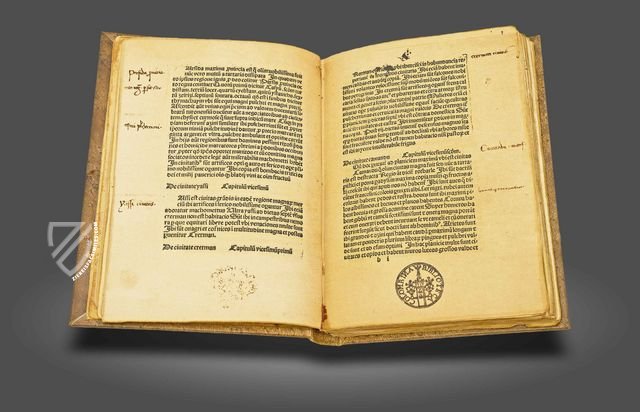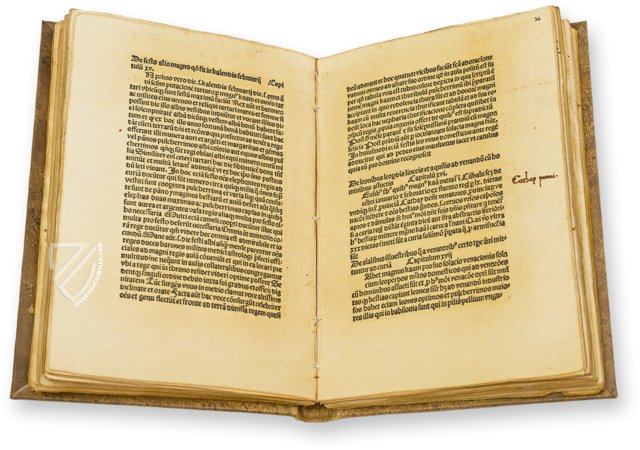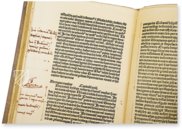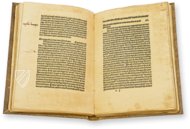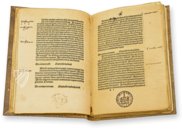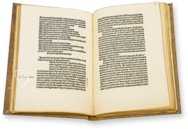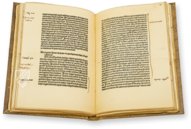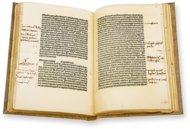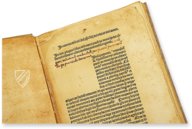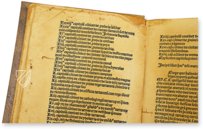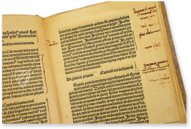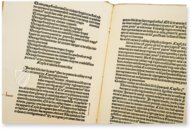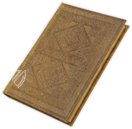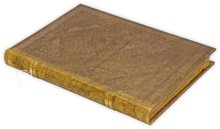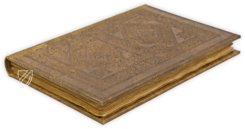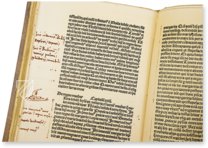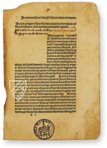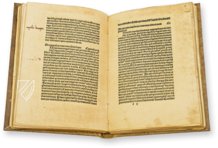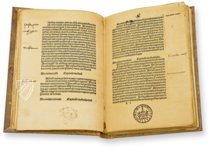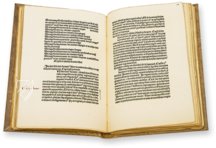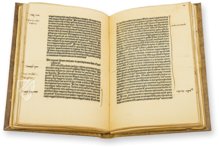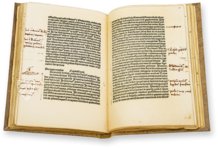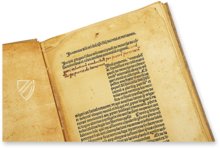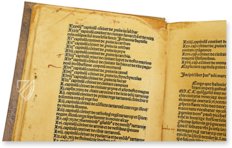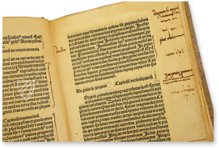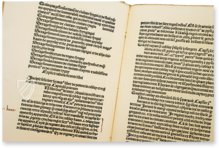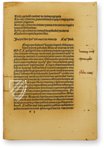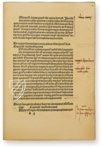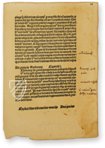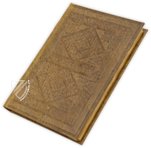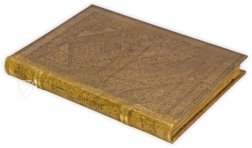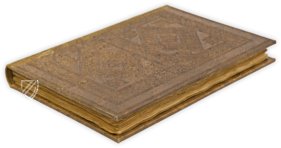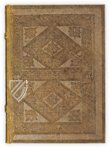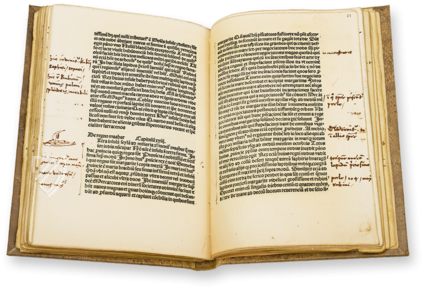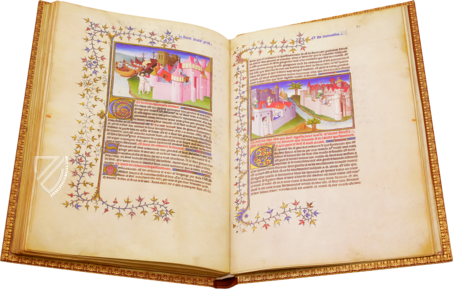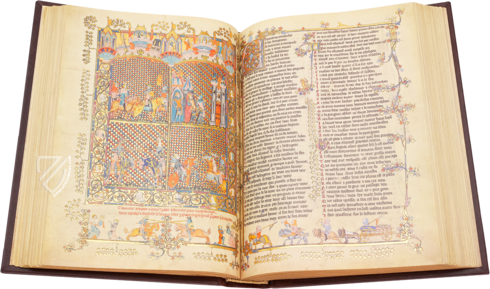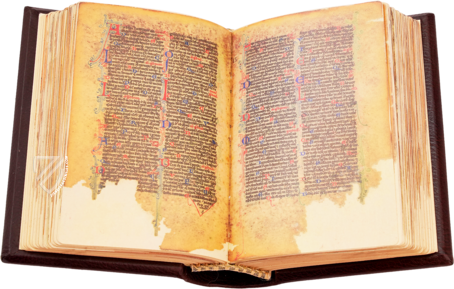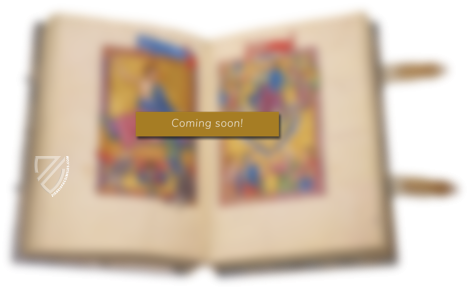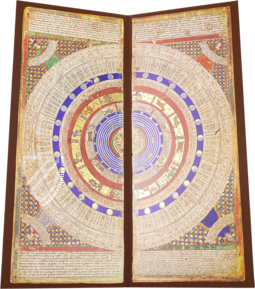De le Meravegliose Cose del Mondo
(under 1,000€)
The famous Book of the Wonders of the World by Marco Polo is one of the most famous travelogues in history. The description of his stay in central Asia in the years 1271–1295 was the definitive source of information about China, its geography, and its culture. This account also inspired many great explorers on their own travels into unknown regions of the world. The first Italian Marco Polo incunabulum, an early printed book originating before 1501, presents the fabulous travelogue in a wonderful mix of Gothic and Romanic script.
De le Meravegliose Cose del Mondo
Marco Polo (1253–1324) is considered to be the most famous traveler of the Middle Ages up to this day. De le Meravegliose Cose del Mondo (Book of the Marvels of the World) is the Italian title of the tale of his residency in central Asia from 1271–1295. The first Italian Marco Polo incunabulum, an early printed book originating before 1501, presents the fabulous travelogue in a wonderful mix of Gothic and Romanic script. It was published on June 13th, 1496 in the Venetian printing house of Giovanni Battista Sessa and the specimen at hand represents the only copy to be found in Spain. As such, it is jealously guarded in the Biblioteca del Palacio Real de Madrid as a book gem of enormous worth.
A Venetian Merchant’s Son in China
As a 17-year-old, Marco Polo, the son of an important Venetian merchant, came to the court of the Mongol ruler Kublai Khan (1215–94) in Peking along with his father and an uncle. Their path drove them from Palestine across Persia, Pakistan, and the Pamir Mountains to China. There the young Venetian abode as a high envoy and trusted friend of the Kahn’s and toured for years through modern China, Vietnam, and Myanmar. In 1292, Marco Polo took himself aboard ship across the Indian Ocean to Venice, where he remained and started a family. During the Venice’s war with Genoa, the adventurer was kept prisoner in a tower for three years together with a writer named Rustichello da Pisa, whom he entrusted with his experiences.
A True Story or the Work of a Swindler?
Rustichello da Pisa’s detailed account enjoyed great fame and wide dissemination, although little is known about him personally. Marco Polo’s story was not taken seriously by his contemporaries and was derided as a tall tale. To some contemporary people these probably seemed to be fantastical because of the unbelievable tales and descriptions of the strange and exotic world. One the other hand, Marco Polo – the author of the tale – did not spare any praise for himself regarding the content of the book, as the following first sentence of the account makes clear: “No man, be he heathen, Christian, or Saracen, has seen so many and such dangerous things since the creation of Adam as the alluded-to Marco Polo.”
A Groundbreaking Work of World History
The travelogue of Marco Polo is transmitted today in numerous handwritten and illuminated manuscripts and was also printed from 1477 onward. Additionally, the travelogue enjoyed translations into many languages, Italian among them, alternately under the title of Il Milione. Thus the travelogue of Marco Polo remained the most important source about China up to the 16th century. Appreciation of the work has also changed over time. Among others, Christopher Columbus used to the work for his voyages of exploration, and also Alexander von Humboldt paid the highest respect to Marco Polo for his travelogue!
Codicology
- Alternative Titles
- Über die wunderbaren Dinge der Welt
Book of the Marvels of the World
Description of the World
Il Milione
The Travels of Marco Polo - Size / Format
- 176 pages / 18.0 × 11.5 cm
- Origin
- Italy
- Date
- June 13, 1496
- Epochs
- Genre
- Language
- Illustrations
- Plain xylographic initials
- Content
- First edition of Marco Polo's travelogue
- Artist / School
- Marco Polo (author)
Giovanni Battista Sessa (printer) - Previous Owners
- Count of Gondomar
De le Meravegliose Cose del Mondo
Marginal Notes
Although this is a fine example of early printing with clear letters and strict margins, the codex itself is not what makes it so fascinating, it is the notes in the margins. They come from the hand of Cristopher Columbus himself, one of the most famous and controversial figures in history, whose personal reflections on the text can be seen here. Codices that were once in the possession of famous historical figures offer rare and valuable insights, humanizing and personalizing history.
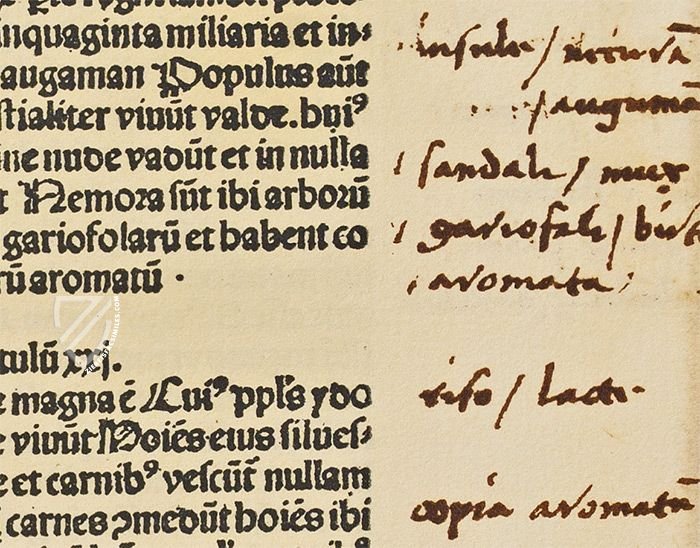
De le Meravegliose Cose del Mondo
Missing Initial Page
This edition of Marco Polo’s famous travelogue as recorded by Rustichello da Pisa is among the earliest Italian incunabula, early printed books from the late–15th and early 16th centuries that still often incorporated hand drawn décor. After purchasing it, the owner of the codex would have it personalized by an artist as though they had commissioned a manuscript.
Here we see a page of printed text that is appended by some handwriting as well as a conspicuous blank space where one would expect a decorative initial. Although the owner of this codex never had it embellished, the space would be sufficient for a historiated initial with a small miniature, presumably a depiction of Marco Polo on his travels in the exotic Orient.
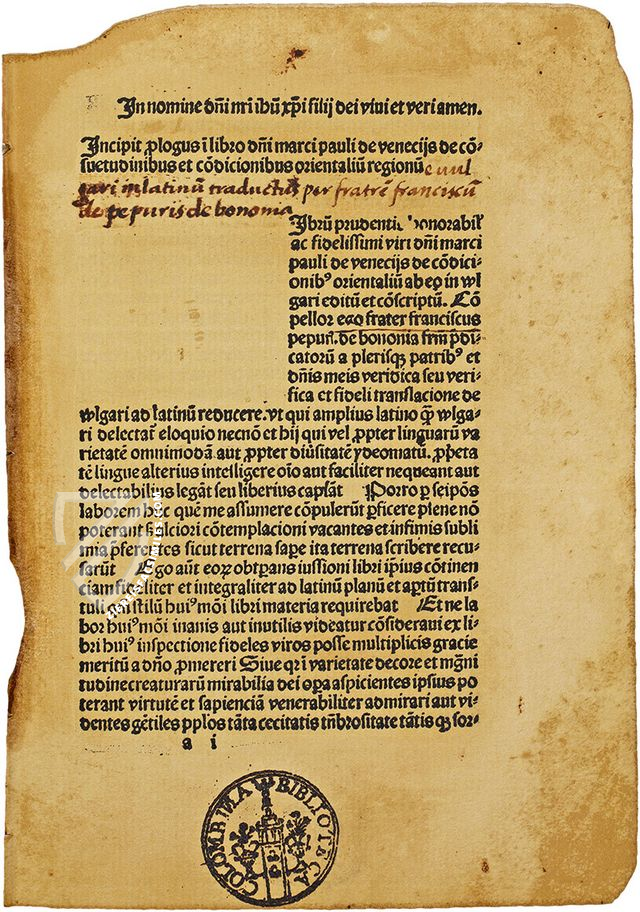
#1 De le Meravegliose Cose del Mondo
Language: Spanish
(under 1,000€)
- Treatises / Secular Books
- Apocalypses / Beatus
- Astronomy / Astrology
- Bestiaries
- Bibles / Gospels
- Chronicles / History / Law
- Geography / Maps
- Saints' Lives
- Islam / Oriental
- Judaism / Hebrew
- Single Leaf Collections
- Leonardo da Vinci
- Literature / Poetry
- Liturgical Manuscripts
- Medicine / Botany / Alchemy
- Music
- Mythology / Prophecies
- Psalters
- Other Religious Books
- Games / Hunting
- Private Devotion Books
- Other Genres
- Afghanistan
- Armenia
- Austria
- Belgium
- Belize
- Bosnia and Herzegovina
- China
- Colombia
- Costa Rica
- Croatia
- Cyprus
- Czech Republic
- Denmark
- Egypt
- El Salvador
- Ethiopia
- France
- Germany
- Greece
- Guatemala
- Honduras
- Hungary
- India
- Iran
- Iraq
- Israel
- Italy
- Japan
- Jordan
- Kazakhstan
- Kyrgyzstan
- Lebanon
- Liechtenstein
- Luxembourg
- Mexico
- Morocco
- Netherlands
- Palestine
- Panama
- Peru
- Poland
- Portugal
- Romania
- Russia
- Serbia
- Spain
- Sri Lanka
- Sweden
- Switzerland
- Syria
- Tajikistan
- Turkey
- Turkmenistan
- Ukraine
- United Kingdom
- United States
- Uzbekistan
- Vatican City
- A. Oosthoek, van Holkema & Warendorf
- Aboca Museum
- Ajuntament de Valencia
- Akademie Verlag
- Akademische Druck- u. Verlagsanstalt (ADEVA)
- Aldo Ausilio Editore - Bottega d’Erasmo
- Alecto Historical Editions
- Alkuin Verlag
- Almqvist & Wiksell
- Amilcare Pizzi
- Andreas & Andreas Verlagsbuchhandlung
- Archa 90
- Archiv Verlag
- Archivi Edizioni
- Arnold Verlag
- ARS
- Ars Magna
- ArtCodex
- AyN Ediciones
- Azimuth Editions
- Badenia Verlag
- Bärenreiter-Verlag
- Belser Verlag
- Belser Verlag / WK Wertkontor
- Benziger Verlag
- Bernardinum Wydawnictwo
- BiblioGemma
- Biblioteca Apostolica Vaticana (Vaticanstadt, Vaticanstadt)
- Bibliotheca Palatina Faksimile Verlag
- Bibliotheca Rara
- Boydell & Brewer
- Bramante Edizioni
- Bredius Genootschap
- Brepols Publishers
- British Library
- C. Weckesser
- Caixa Catalunya
- Canesi
- CAPSA, Ars Scriptoria
- Caratzas Brothers, Publishers
- Carus Verlag
- Casamassima Libri
- Centrum Cartographie Verlag GmbH
- Chavane Verlag
- Christian Brandstätter Verlag
- Circulo Cientifico
- Club Bibliófilo Versol
- Club du Livre
- CM Editores
- Collegium Graphicum
- Collezione Apocrifa Da Vinci
- Comissão Nacional para as Comemorações dos Descobrimentos Portugueses
- Coron Verlag
- Corvina
- CTHS
- D. S. Brewer
- Damon
- De Agostini/UTET
- De Nederlandsche Boekhandel
- De Schutter
- Deuschle & Stemmle
- Deutscher Verlag für Kunstwissenschaft
- DIAMM
- Droz
- E. Schreiber Graphische Kunstanstalten
- Ediciones Boreal
- Ediciones Grial
- Ediclube
- Edições Inapa
- Edilan
- Editalia
- Edition Deuschle
- Edition Georg Popp
- Edition Leipzig
- Edition Libri Illustri
- Editiones Reales Sitios S. L.
- Éditions de l'Oiseau Lyre
- Editions Medicina Rara
- Editorial Casariego
- Editorial Mintzoa
- Editrice Antenore
- Editrice Velar
- Edizioni Edison
- Egeria, S.L.
- Eikon Editores
- Electa
- Emery Walker Limited
- Enciclopèdia Catalana
- Eos-Verlag
- Ephesus Publishing
- Ernst Battenberg
- Eugrammia Press
- Extraordinary Editions
- Fackelverlag
- Facsimila Art & Edition
- Facsimile Editions Ltd.
- Facsimilia Art & Edition Ebert KG
- Faksimile Verlag
- Feuermann Verlag
- Folger Shakespeare Library
- Franco Cosimo Panini Editore
- Friedrich Wittig Verlag
- Fundación Hullera Vasco-Leonesa
- G. Braziller
- Gabriele Mazzotta Editore
- Gebr. Mann Verlag
- Gesellschaft für graphische Industrie
- Getty Research Institute
- Giovanni Domenico de Rossi
- Giunti Editore
- Graffiti
- Grafica European Center of Fine Arts
- Guido Pressler
- Guillermo Blazquez
- Gustav Kiepenheuer
- H. N. Abrams
- Harrassowitz
- Harvard University Press
- Helikon
- Hendrickson Publishers
- Henning Oppermann
- Herder Verlag
- Hes & De Graaf Publishers
- Hoepli
- Holbein-Verlag
- Houghton Library
- Hugo Schmidt Verlag
- Idion Verlag
- Il Bulino, edizioni d'arte
- ILte
- Imago
- Insel Verlag
- Insel-Verlag Anton Kippenberger
- Instituto de Estudios Altoaragoneses
- Instituto Nacional de Antropología e Historia
- Introligatornia Budnik Jerzy
- Istituto dell'Enciclopedia Italiana - Treccani
- Istituto Ellenico di Studi Bizantini e Postbizantini
- Istituto Geografico De Agostini
- Istituto Poligrafico e Zecca dello Stato
- Italarte Art Establishments
- Jan Thorbecke Verlag
- Johnson Reprint Corporation
- Josef Stocker
- Josef Stocker-Schmid
- Jugoslavija
- Karl W. Hiersemann
- Kasper Straube
- Kaydeda Ediciones
- Kindler Verlag / Coron Verlag
- Kodansha International Ltd.
- Konrad Kölbl Verlag
- Kurt Wolff Verlag
- La Liberia dello Stato
- La Linea Editrice
- La Meta Editore
- Lambert Schneider
- Landeskreditbank Baden-Württemberg
- Leo S. Olschki
- Les Incunables
- Liber Artis
- Library of Congress
- Libreria Musicale Italiana
- Lichtdruck
- Lito Immagine Editore
- Lumen Artis
- Lund Humphries
- M. Moleiro Editor
- Maison des Sciences de l'homme et de la société de Poitiers
- Manuscriptum
- Martinus Nijhoff
- Maruzen-Yushodo Co. Ltd.
- MASA
- Massada Publishers
- McGraw-Hill
- Metropolitan Museum of Art
- Militos
- Millennium Liber
- Müller & Schindler
- Nahar - Stavit
- Nahar and Steimatzky
- National Library of Wales
- Neri Pozza
- Nova Charta
- Oceanum Verlag
- Odeon
- Orbis Mediaevalis
- Orbis Pictus
- Österreichische Staatsdruckerei
- Oxford University Press
- Pageant Books
- Parzellers Buchverlag
- Patrimonio Ediciones
- Pattloch Verlag
- PIAF
- Pieper Verlag
- Plon-Nourrit et cie
- Poligrafiche Bolis
- Presses Universitaires de Strasbourg
- Prestel Verlag
- Princeton University Press
- Prisma Verlag
- Priuli & Verlucca, editori
- Pro Sport Verlag
- Propyläen Verlag
- Pytheas Books
- Quaternio Verlag Luzern
- Reales Sitios
- Recht-Verlag
- Reichert Verlag
- Reichsdruckerei
- Reprint Verlag
- Riehn & Reusch
- Roberto Vattori Editore
- Rosenkilde and Bagger
- Roxburghe Club
- Salerno Editrice
- Saltellus Press
- Sandoz
- Sarajevo Svjetlost
- Schöck ArtPrint Kft.
- Schulsinger Brothers
- Scolar Press
- Scrinium
- Scripta Maneant
- Scriptorium
- Shazar
- Siloé, arte y bibliofilia
- SISMEL - Edizioni del Galluzzo
- Sociedad Mexicana de Antropología
- Société des Bibliophiles & Iconophiles de Belgique
- Soncin Publishing
- Sorli Ediciones
- Stainer and Bell
- Studer
- Styria Verlag
- Sumptibus Pragopress
- Szegedi Tudomànyegyetem
- Taberna Libraria
- Tarshish Books
- Taschen
- Tempus Libri
- Testimonio Compañía Editorial
- Thames and Hudson
- The Clear Vue Publishing Partnership Limited
- The Facsimile Codex
- The Folio Society
- The Marquess of Normanby
- The Richard III and Yorkist History Trust
- Tip.Le.Co
- TouchArt
- TREC Publishing House
- TRI Publishing Co.
- Trident Editore
- Tuliba Collection
- Typis Regiae Officinae Polygraphicae
- Union Verlag Berlin
- Universidad de Granada
- University of California Press
- University of Chicago Press
- Urs Graf
- Vallecchi
- Van Wijnen
- VCH, Acta Humaniora
- VDI Verlag
- VEB Deutscher Verlag für Musik
- Verlag Anton Pustet / Andreas Verlag
- Verlag Bibliophile Drucke Josef Stocker
- Verlag der Münchner Drucke
- Verlag für Regionalgeschichte
- Verlag Styria
- Vicent Garcia Editores
- W. Turnowski Ltd.
- W. Turnowsky
- Waanders Printers
- Wiener Mechitharisten-Congregation (Wien, Österreich)
- Wissenschaftliche Buchgesellschaft
- Wissenschaftliche Verlagsgesellschaft
- Wydawnictwo Dolnoslaskie
- Xuntanza Editorial
- Zakład Narodowy
- Zollikofer AG

